AUDI Q5 2016 Owners Manual
Manufacturer: AUDI, Model Year: 2016, Model line: Q5, Model: AUDI Q5 2016Pages: 300, PDF Size: 75.02 MB
Page 251 of 300
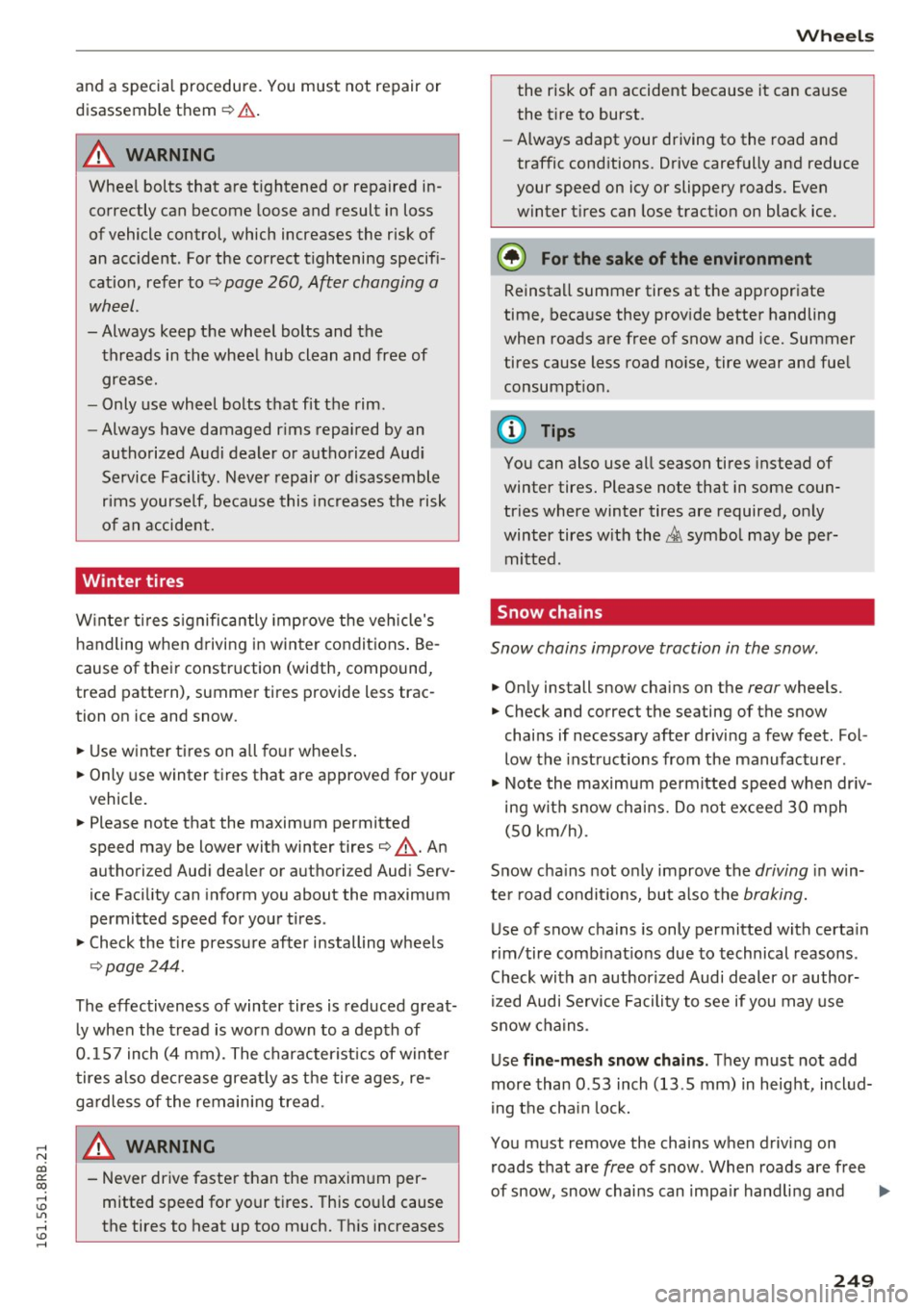
,....,
N
co
er::
co
,....,
disassemble them ¢.&. .
A WARNING
Wheel bolts that are tightened or repaired in
correctly can become loose and result in loss
of vehicle control, which increases the risk of
an acc ident. For the correct tightening specifi
cation, refer to ¢
page 260, After changing a
wheel .
- Always keep the wheel bolts and the
threads in the wheel hub clean and free of grease.
- Only use wheel bolts that fit the rim .
- Always have damaged r ims repa ired by an
authorized Audi dealer o r autho rized Aud i
Service Facility . Never repair or d isassemble
rims yourself, because this increases the risk
of an accident.
Winter tires
W inte r ti res s ignificantly improve the vehicle's
h andling when driving in win ter condit ions . Be
cause of the ir constr uction (width, compound,
tread pattern), summer tires provide less trac
tion on ice and snow .
"'U se winter t ires on all fo ur wheels .
.. Only use winter t ires that are approve d for your
v ehicl e.
"' Please note that the maximum permitted
speed may be lower with winter tires¢.&_ . An
authorized Aud i dealer or au thori zed Aud i Serv
ice Fac ility can inform you about the maximum
permitted speed fo r your tires .
"' Check the tire press ure after installing wheels
¢page 244.
The effectiveness of winter tires is reduced great
l y when the tread is worn down to a depth of
0 .1 57 inch (4 mm). The character ist ics of winter
tires a lso de crease great ly as the tire ages, re
ga rdless of the remain ing tread.
WARNING
- Never drive faster than the maxim um per
mitted speed for your t ires. This cou ld cause
the tires to heat up too much. Th is increases
Wh eel s
the risk of an accident because it can cause
the t ire to burst.
- Always adapt your driving to the road and
traffic cond itions . Drive carefully and reduce
your speed on icy or slippery roads . Even
winter t ires can lose tract io n on black ice.
@ For the sake of the environment
Reinsta ll summer tires at the app ropr iate
time, beca use they prov ide better handling
when roads are free of snow and ice. Summer
tires cause less road no ise, tire wear and fue l
consumpt io n.
(D Tips
You can also use all season tires instead of
winter tires. Please note that in some coun
tries where winter tires are required, on ly
winter tires w ith the
& symbo l may be per
mitted .
Snow chains
Snow chains improve traction in the snow.
"'On ly install snow chains on the rear wheels.
"' Check and correct the seating of the snow
chains if necessary after drivi ng a few feet. Fol
low the instructions from the manufacturer .
"' Note the maximum pe rmitted spe ed wh en dr iv
ing w it h snow cha ins. Do not excee d 30 mph
( SO km/h) .
S now c ha ins not o nly improve the
driving in win
te r road condit io ns, but also the
braking.
Use of snow chains is only permitted w ith certa in
r im/tire comb inat ions due to technical reasons .
Check with an author ized Audi dealer or author
ized Audi Service Facility to see if you may use
snow chains.
U se
fine-mesh snow chains . They must not add
more than 0 .53 inch (13 .5 mm) in heig ht, incl ud
ing the cha in lock.
You m ust remove the chai ns when driving on
r oads t hat are
free of snow . When roads are free
of snow, snow chai ns can impa ir han dling and .,.
249
Page 252 of 300
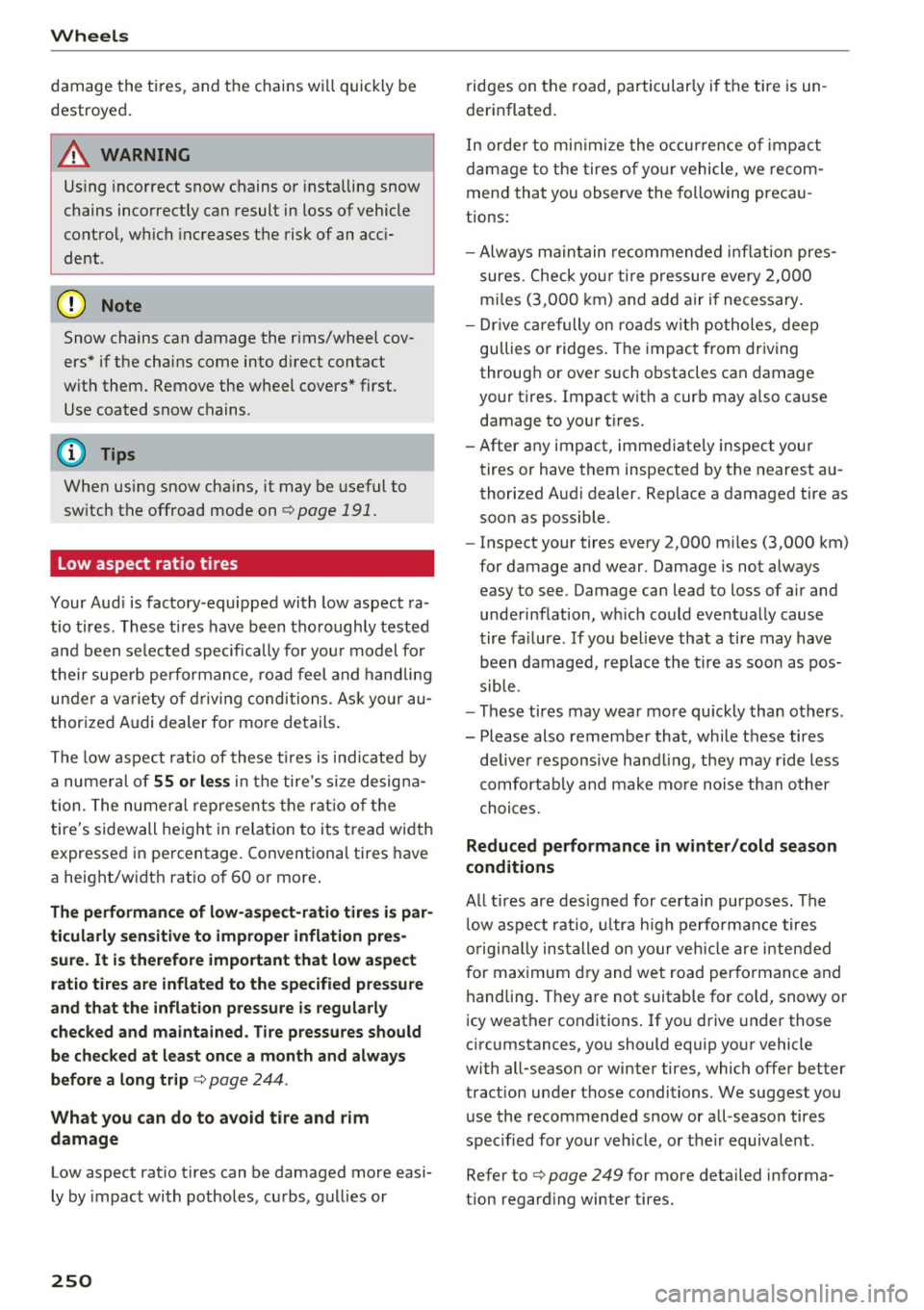
Wheels
damage the ti res, and the chains w ill quickly be
destroyed .
A WARNING
Using incorrect snow chains or insta lling snow
chains incorrectly can result in loss of vehicle
control, which increases the risk of an acc i
dent .
(D Note
Snow chains can damage the rims/wheel cov
ers * if the chains come into d irect contact
w ith them. Remove the wheel covers* first .
Use coated snow chains.
(D Tips
When using snow cha ins, it may be useful to
sw itch the off road mode on
<=> page 191.
Low aspect ratio tires
Your Aud i is factory -equipped with low aspect ra
tio tires. These t ires have been tho roughly tested
a nd been se lected specifically fo r yo ur model fo r
thei r supe rb per fo rman ce , road feel and handling
un der a va riety of d riving conditions . As k yo ur au
thor ized Audi dealer for mo re details .
T he low aspect ratio of these t ires is in dicated by
a nume ral of
55 or less in the tire's size desig na
tion . The numera l rep resents the rat io o f th e
tire's sidewall he ight in relat ion to its tread width
expressed in pe rcentage. Conventional tires have
a height/w idt h rat io o f 60 o r more .
The performance of low-aspect -ra tio tires i s par
ticularly sensitive to improper inflation pres
sure . It is therefore important that low aspect
ratio tires are inflated to the specified pressure
and that the inflation pressure is regularly
checked and maintained . Tire pressures should
be checked at least once a month and always
before a long trip <=>
page 244.
What you can do to avoid tire and rim
damage
Low aspect rat io tires can be damaged more easi
ly by impact with potholes, cu rbs, gullies or
250
ridges on the road, particularly if the tire is un
derinflated.
I n orde r to mi nimize the occur rence o f imp act
dam age to the tires o f yo ur vehicle, we recom
mend that you observe the following preca u
tions:
- Always m aintain reco mmende d in fla tion pres
sures. Check yo ur tir e pressure eve ry 2,0 00
m iles (3,00 0 km) and add air if necessary .
- Dr ive c arefully on ro ads w ith potholes, deep
gu llies o r ridges . The impact from dr iving
through or over such obstacles can damage
your tires. Impact with a curb may a lso ca use
damage to your t ires.
- After any impact, immediate ly inspect you r
tires or have them inspected by the nearest au
thorized Aud i dealer. Replace a damaged tire as
soon as possible.
- Inspect your tires every 2,000 m iles (3,000 km)
for damage and wear . Damage is not always
easy to see . Damage can lead to loss of a ir and
unde rinflation, w hich could event ua lly cause
tire fa ilure . If you believe that a tire may have
be en damaged, replace the tire as soon as pos
sible .
- These tires may wear mo re quickly than o thers .
- Please also remember that, while these tires delive r responsive hand ling, they may ride less
comfortab ly and make mo re noise than o ther
choi ces.
Reduced performance in winter/cold season
conditions
A ll tires are des igned for certain purposes. The
l ow aspect ratio, ultra h igh performance tires
o rigin ally ins talle d on your veh icle are inten ded
for m aximum dry and wet road per forma nce and
handling . They a re not suitable for co ld, snowy or
i cy weather conditions . If you drive under those
c ir cumstances, you should equip yo ur vehicle
with all-season o r winter tires, which offer better
tract ion under t hose conditions. We suggest you
u se the recommended s now or all-season tires
spec ified for your vehicle, o r the ir equiva lent .
Refer to<=>
page 249 for more detailed informa
tion regard ing winter tires.
Page 253 of 300
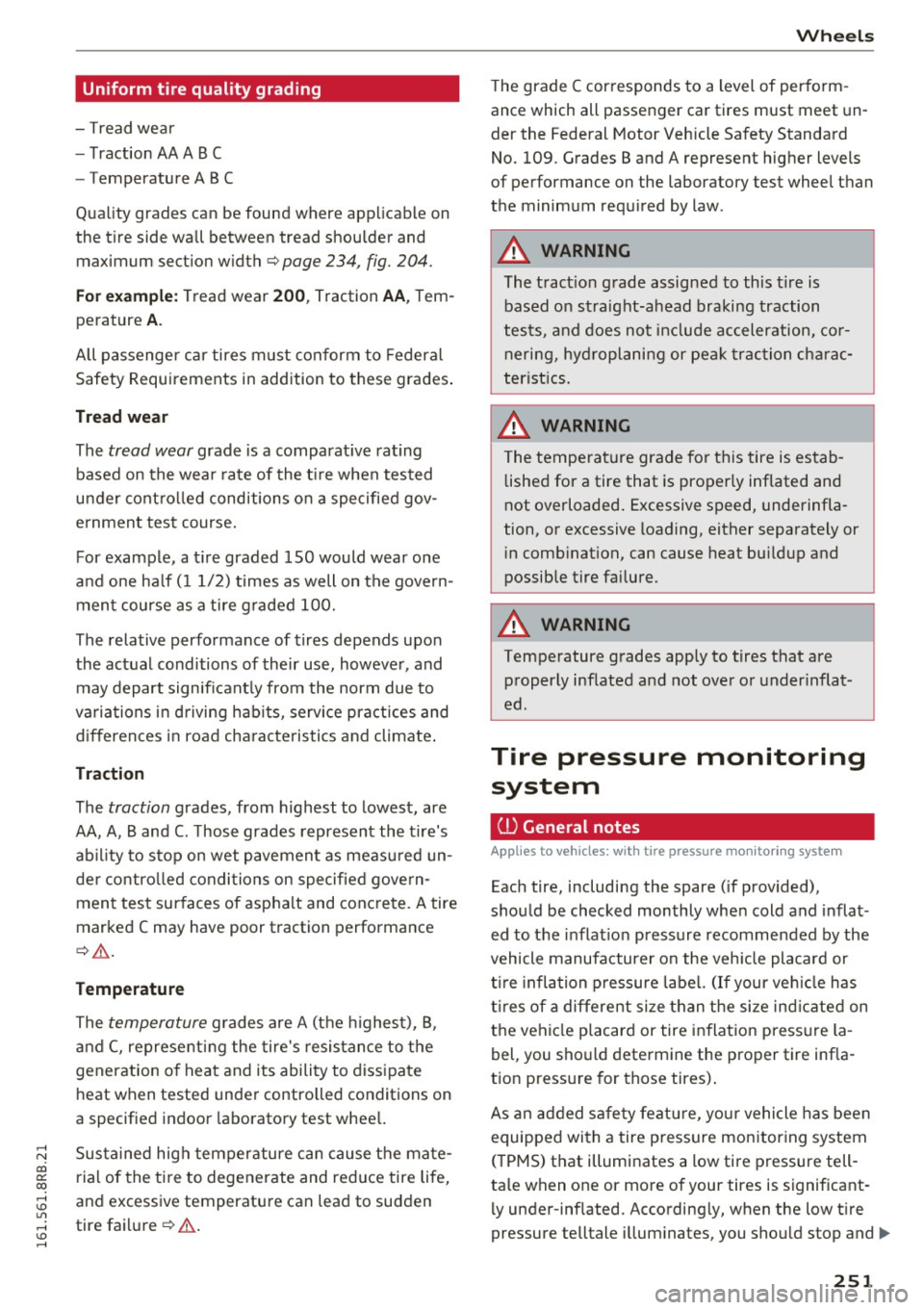
,....,
N
co
er::
co
,....,
- T read wear
- Traction AA A B C
- Temperature ABC
Qua lity grades can be found where applicable on
the tire side wall between tread shoulder and
maximum sect ion w idth
c:> page 234, fig. 204.
For example: Tread wear 200 , Traction AA, Tem
perature
A .
All passenge r ca r tires m ust conform to Federal
Safety Requirements in add ition to these grades .
Tread wear
The tread wear grade is a comparat ive rating
based on the wear rate of the t ire when tested
under cont ro lled conditions o n a specified gov
e rnment test course.
For example, a t ire graded
1 50 would wear one
and one ha lf
( 1 1/2) times as well on the gove rn
men t course as a tire g raded
100.
The relative performance of t ires depends upo n
the actual conditions of their use, howeve r, and
may depart significant ly from the norm due to
va ria tions in driving ha bits, serv ice practices and
d ifferences in road cha racteristics and climate .
Traction
The traction grades, from highest to lowest, are
AA, A, B and
C. T hose grades represent the t ire's
ab il ity to stop on wet pavement as meas ured un
de r contro lled condi tions on specified gove rn
ment tes t sur faces of asphalt and conc re te. A tire
mar ked C may have poor traction performance
c:> &. .
Temperature
The temperature grades are A (t he hi ghest), B ,
a nd C, represent ing the tire's resis tan ce to t he
generation o f heat and its ability to diss ipate
h eat when tested unde r contro lled conditions on
a specified indoor laboratory test whee l.
Sus ta ined hig h temper ature c an cause t he mate
r ial of the ti re to degenerate and red uce tire life,
and excessive temperatu re can lea d to sud den
tire fai lure
c:> &..
Wh eel s
The grade C cor responds to a level of perform
ance which all passenger car tires must meet un
der the Federal Motor Vehicle Safety Standa rd
No.
109 . Grades Band A represent higher levels
of pe rformance on the laboratory test wheel than
the minimum req uired by law .
A WARNING ,-
The tractio n grade assigned to this tire is
based on st raight-a head braking traction
t es ts, and does no t include acceler ation, co r
n eri ng, hy dropla ning or pe ak tra ction charac
terist ics.
A WARNING ,.,___
The tempera ture grade for this tire is estab
lished for a tire that is properly inflated and
not overloaded . Excessive speed, underinfla
tion, or excessive loading, either separate ly or
i n comb inat ion, can cause heat bu ildup and
possib le tire fai lure.
A WARNING
-
Temperature g rades apply to tires that are
p roperly inflated a nd not over o r under inflat
ed.
Tire pressure monitoring system
ill General notes
App lies to vehicles: wi th tire pressure mo nito rin g syste m
-
Each tire, including the spare (if provided),
should be checked monthly whe n cold and inflat
ed to the inflat io n pressure recommended by the
vehicle manufacturer on the veh icle placard or
t ir e infla tion p ressure la be l. (If your ve hicle has
t ir es of a different size than t he si ze ind ic a ted on
the vehi cle placar d or tire in flat ion press ure la
bel, you sho uld dete rmine the proper tire infla
t ion press ure for those tires) .
As an ad ded s afety feat ure, yo ur vehicle has been
equipped with a tire press ure mon itor ing system
( T PMS) t hat illuminates a low tire pressure tell
ta le when one or mo re of your tires is signif icant -
ly under-inf lated. According ly, when the low t ire
pressure telltale i llum inates, you shou ld stop and.,.
251
Page 254 of 300
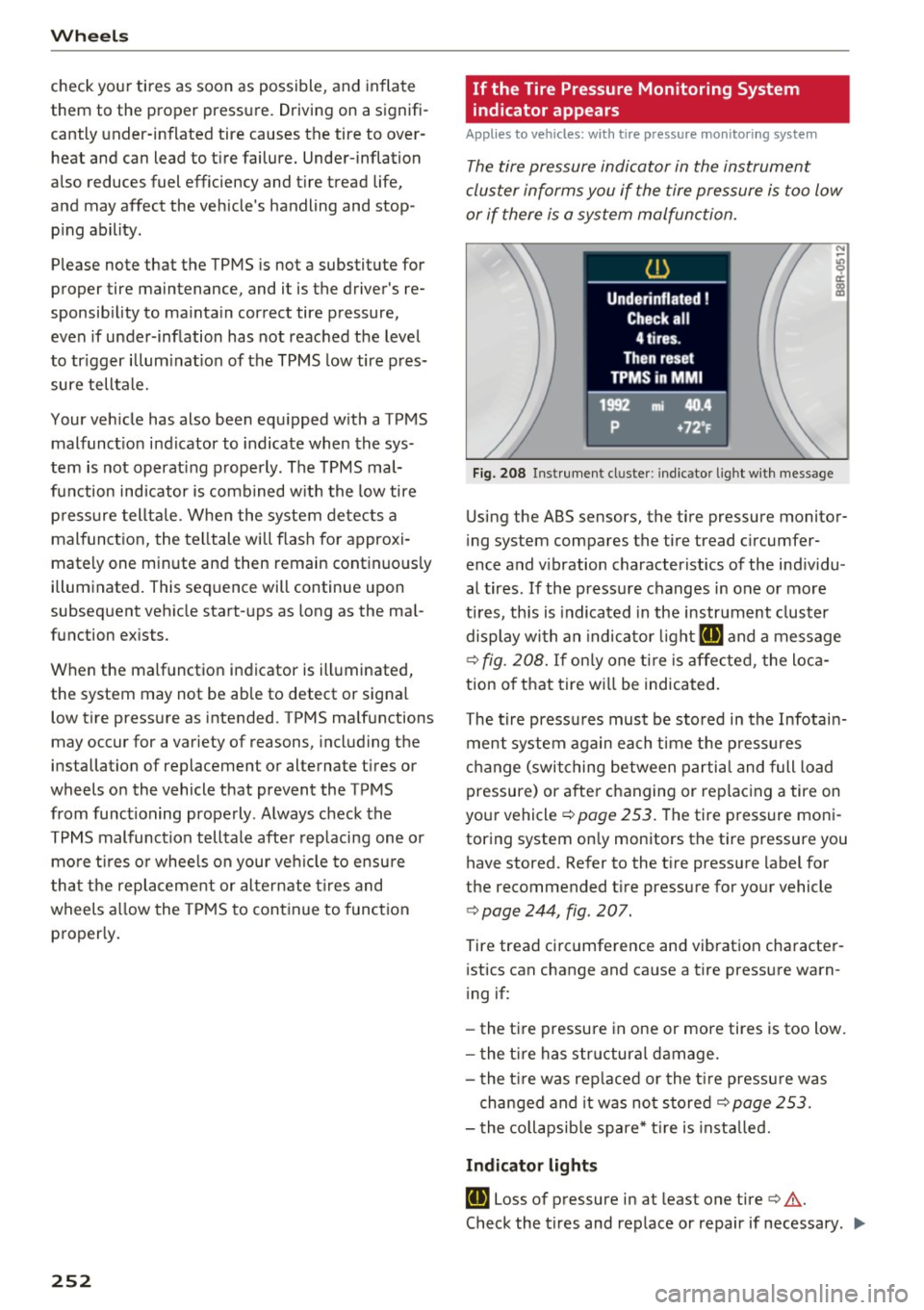
Wheels
check your tires as soon as possible, and inflate
them to the proper pressure. Driving on a signifi
cantly under-inflated tire causes the tire to overheat and can lead to tire failure. Under-inflation
also reduces fuel efficiency and tire tread life,
and may affect the vehicle's handling and stop
ping ability.
Please note that the TPMS is not a substitute for
proper tire maintenance, and it is the driver's re
sponsibility to maintain correct tire pressure,
even if under-inflation has not reached the level
to trigger illumination of the TPMS low tire pres
sure telltale.
Your vehicle has also been equipped with a TPMS malfunction indicator to indicate when the sys
tem is not operating properly. The TPMS mal
function indicator is combined with the low tire pressure telltale. When the system detects a
malfunction, the telltale will flash for approxi
mately one minute and then remain continuously
illuminated. This sequence will continue upon
subsequent vehicle start-ups as long as the mal
function exists .
When the malfunction indicator is illuminated,
the system may not be able to detect or signal low tire pressure as intended . TPMS malfunctions
may occur for a variety of reasons, including the
installation of replacement or alternate tires or
wheels on the vehicle that prevent the TPMS from functioning properly . Always check the
TPMS malfunction telltale after replacing one or
more tires or wheels on your vehicle to ensure
that the replacement or alternate tires and
wheels allow the TPMS to continue to function
properly.
252
· If the Tire Pressure Monitoring System
indicator appears
Applies to vehicles: with tire pressure monitoring system
The tire pressure indicator in the instrument
cluster informs you if the tire pressure is too low
or if there is a system malfunction.
Fig. 208 Instrument cl uster: i ndic ator ligh t with message
Using the ABS sensors, the tire pressure monitor
ing system compares the tire tread circumfer
ence and vibration characteristics of the individu
al tires . If the pressure changes in one or more
tires , this is indicated in the instrument cluster
display with an indicator light
RE and a message
c>fig. 208. If only one tire is affected, the loca
tion of that tire will be indicated.
The tire pressures must be stored in the Infotain
ment system again each time the pressures
change (switching between partial and full load
pressure) or after changing or replacing a tire on
your vehicle
c> page 253. The tire pressure moni
toring system only monitors the tire pressure you have stored. Refer to the tire pressure label for
the recommended tire pressure for your vehicle
c> page 244, fig . 207.
Tire tread circumference and vibration character
istics can change and cause a tire pressure warn
ing if:
- the tire pressure in one or more tires is too low.
- the tire has structural damage.
- the tire was replaced or the tire pressure was
changed and it was not stored
c> page 253 .
-the collapsible spare* tire is installed.
Indicator lights
RE Loss of pressure in at least one tire c> &.
Check the tires and replace or repair if necessary . .,.
Page 255 of 300
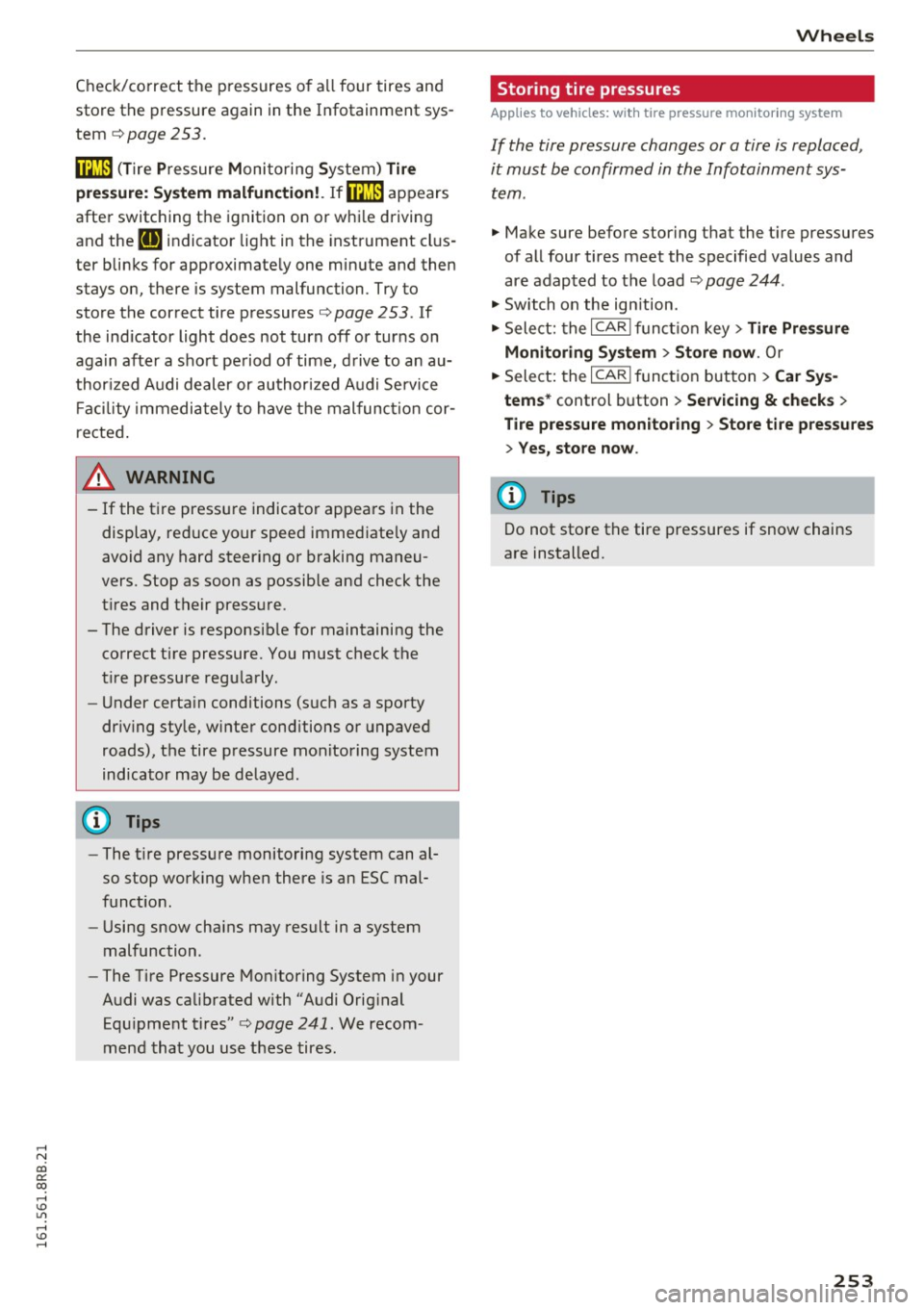
,....,
N
co
er::
co
,....,
store the pressure again in the Infotainment sys
tem
¢ page 253.
mm (T ire Pressure Monitoring System) Tire
pressu re: S ys tem malfunction !. If m:m
appears
after switching the ignition on or whi le driving
and the
all indicator light in the instrument clus
ter blinks for approximate ly one minute and then
stays on, there is system malfunction. Try to
store the correct tire pressures¢
page 253. If
the ind icator light does not turn off or turns on
again after a short period of time, drive to an au
thor ized Audi dealer or authorized Audi Se rvice
F ac ility immediately to have the malfunction cor
rected .
& WARNING ,___ -
- If the tire pressure indicator appears in the
display, reduce your speed immed iate ly and
avoid any hard steering or braking maneu
vers. Stop as soon as possib le and check the
t ires and their pressure.
- The driver is responsib le for maintaining the
correct tire pressure. You must check the
t ire pressure regu larly.
- Under certa in conditions (such as a sporty
driv ing style, winter cond itions or unpaved
roads), the tire p ressure monitoring system
indicator may be delayed.
(D Tips
- The t ire pressure monitoring system can al
so stop work ing when there is an ESC mal
funct ion.
- Using snow chains may result in a system
malfunction.
- The Tire Pressure Mon itoring System in your
Audi was calibrated with "Audi Orig inal
Equ ipment tires"¢
page 241. We recom
mend that you use these tires .
Wheel s
Storing tire pressures
App lies to vehicles : wi th tire pressure monitor ing syste m
If the tire pressure changes or a tire is replaced,
it must be confirmed in the Infotainment sys
tem .
.,.. Make sure before storing t hat the t ire pressures
of all four tires meet the specified values and
are adapted to the load
¢ page 244.
.,.. Switch on the ign ition.
.,.. Select: the
I CAR ! funct io n key> Tire Press ure
Monitoring Sy stem > Store now .
Or
.,.. Sele ct: the
I CAR I funct ion but ton > Car S ys
tem s*
control b utton > Servicing & check s >
Tire pressure mon itoring > Sto re tire pre ssures
> Yes , store now .
(D Tips
Do not store the tire pressures if snow chains
are installed.
253
Page 256 of 300
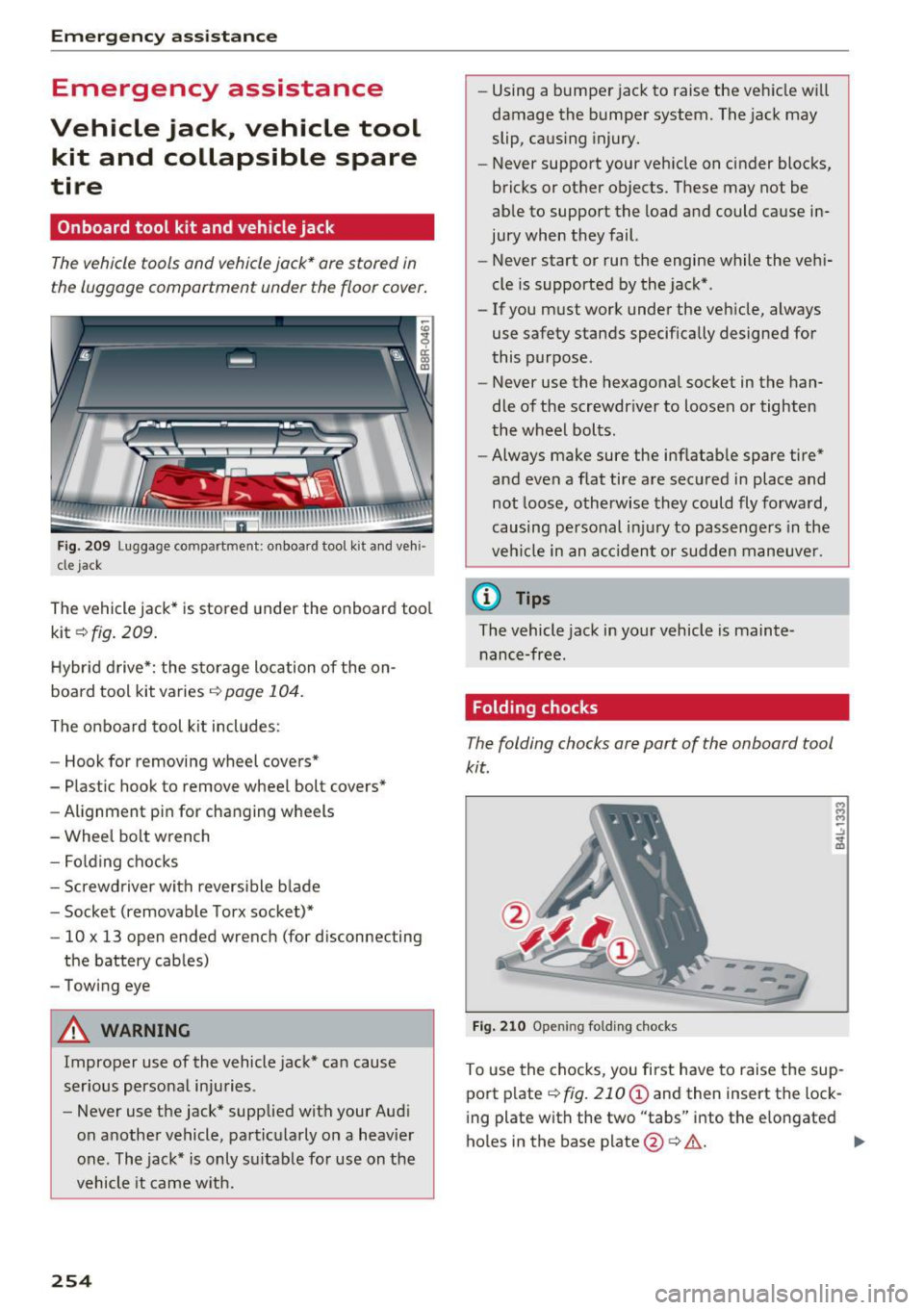
Emerg ency assis ta nce
Emergency assistance
Vehicle jack, vehicle tool kit and collapsible spare
tire
Onboard tool kit and vehicle jack
The vehicle tools and vehicle jock* ore stored in
the luggage comportment under the floor cover.
Fig. 209 Luggage compartment: on board tool kit and vehi
cle jack
The vehicle jack* is stored under the onboard tool
kit ¢ fig. 209.
Hybr id d rive*: the storage location of the on
board tool kit varies ¢ page 104.
The onboard tool k it includes:
- Hook for removing wheel covers*
- Plastic hook to
remove wheel bolt covers*
-Alignment pin for changing wheels
- Wheel bolt wrench
- Folding chocks
- Screwdriver with revers ible blade
- Socket (removable Torx socket)*
- 10 x 13 open ended wrench (for disconnecting
the battery cables)
- Towing eye
A WARNING
Improper use of the vehicle jack* can cause
ser ious personal injuries.
- Never use the jack* supplied with your Aud i
on another vehicle, particularly on a heavier
one. The jack* is only su itable for use on the
vehicle it came w ith.
254 -
Using a bumper jack to raise the vehicle will
damage the bumper system. The jack may
slip, caus ing injury.
- Never support your vehicle on cinder blocks,
bricks or other objects. These may not be
able to support the load and could cause in
jury when they fail.
- Never start or run the engine while the vehi
cle is supported by the jack* .
- If you must work under the vehicle, always
use safety stands specifically designed for
this purpose .
- Never use the hexagonal socket in the han
dle of the screwdr iver to loosen or tighten
the wheel bolts .
- Always make sure the inflatable spare tire*
and
even a flat tire are secu red in place and
not loose, otherwise they could fly forward,
causing personal inj ury to passenge rs in the
vehi cle in an a cc ident or sudden maneuve r.
@ Tips
The vehicle jack in your vehicle is mainte
nance-free.
Folding chocks
The folding chocks ore port of the on board tool
kit .
---
Fig . 210 Open ing fo lding chocks
To use the chocks, you fi rst have to raise the sup
port plate
¢ fig. 210 (D and then insert the lock
ing plate with the two "tabs" into the elongated
holes in the base plate
@ c> &.. .,,_
Page 257 of 300
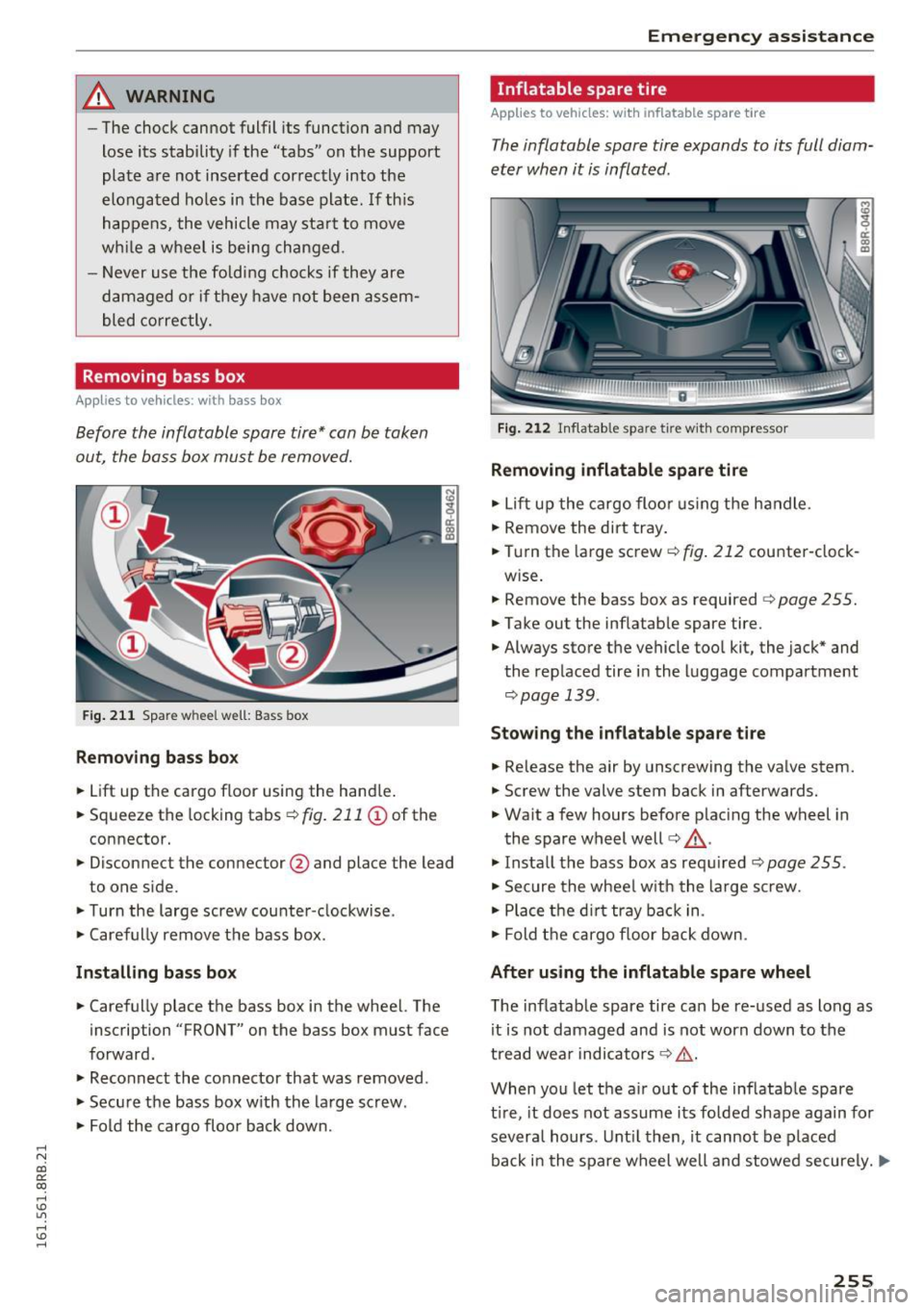
..... N
co ~ CX)
..... I.Cl U"I
..... I.Cl .....
_& WARNING
-The chock cannot fulfil its function and may
lose its stability if the "tabs" on the support
plate a re not inserted correctly into the
elongated holes in the base plate. If th is
happens, the vehicle may sta rt to move
wh ile a wheel is being changed.
- Never use the fold ing chocks if they are
damaged or if they have not been assem
bled co rrectly.
Removing bass box
Appl ies to vehicles : wit h bass box
Before the inflatable spare tire* can be token
out, the bass box must be removed.
Fig . 21 1 Spare w heel well: Bass box
Removing ba ss box
"Lift up the cargo floor using the hand le .
" Squeeze the locking tabs
c:> fig . 211 (D of the
connector.
" Disconnect the connector @and place the lead
to one s ide.
"T urn the large screw counter -clockwise .
" Carefully remove t he bass box .
Installing bas s bo x
"Carefully place the bass box in the whee l. The
inscription "FRONT" on the bass box must face
forward.
" Reconnect the co nnector that was removed.
" Secu re the bass box w ith the la rge screw .
" Fold the cargo floo r bac k down.
Em ergen cy a ssis tanc e
Inflatable spare tire
Applies to vehicles: w ith inflatable spare tire
The inflatable spare tire expands to its full diam
eter when it is inflated .
Fig. 212 In flatable spare tire wit h comp ressor
Removing inflatabl e spare tire
"Lift up the cargo floo r us ing the handle.
" Remove the dirt tray .
" Turn the large screw <=:>
fig. 212 counter -clock-
w ise .
" Remove the bass box as required<=:>
page 255.
"Take out the inflatab le spare tire.
" Always store the vehicle too l kit, the jack* and
the replaced tire in the luggage compartment
<=:> page 139.
Stowing the inflatable spare t ire
.. Release the air by unscrewing the valve stem.
" Screw the valve stem back in afterwards.
" Wa it a few hours before plac ing the wheel in
the spare wheel well<=:>,& .
" Insta ll the bass box as required <=:>
page 255 .
" Secure the whee l w ith the la rge sc rew.
" Place t he d irt tray back in .
" Fold t he c argo floor back down .
After using the inflatable spare wheel
The inflatable spare tire can be re-used as long as
it is not damaged and is not worn down to the
tread wea r indicators
c:> .&, .
When you let the a ir out of the inf latab le spare
t ir e, it does not assume its folded shape again for
severa l hours . Unt il then, it cannot be placed
back i n the spare wheel well and stowed securely.
IJI>
255
Page 258 of 300
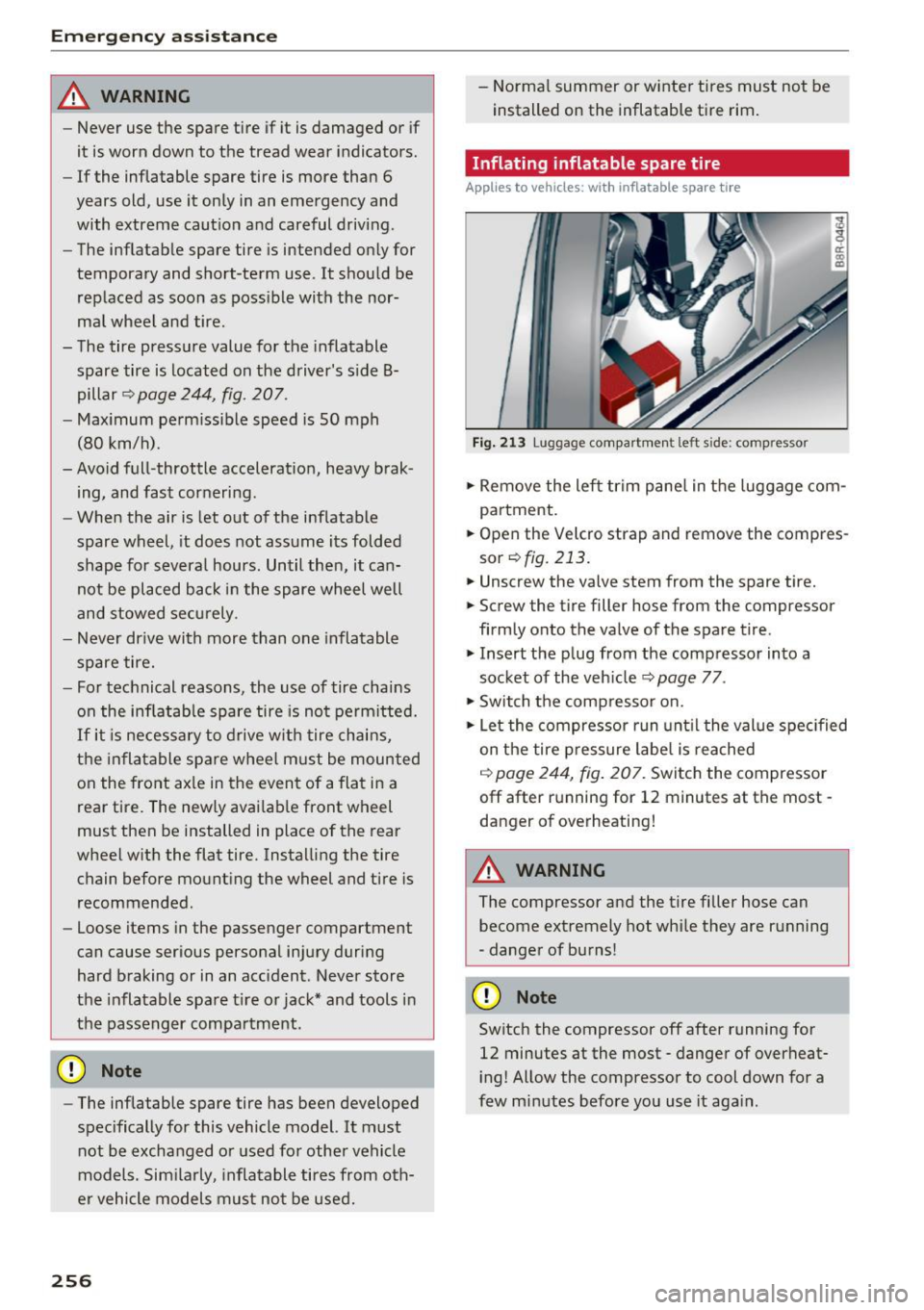
Emerg ency assis ta nce
_& WARNING
- Never use the spare tire if it is damaged or if
it is worn down to the tread wear indicators .
- If the inflatable spare tire is more than 6
years old, use it only in an emergency and
with extreme caut ion and careful driving.
- The inflatable spare tire is intended only for
temporary and short-term use . It should be
replaced as soon as poss ible with the nor
mal wheel and tire.
- The tire pressure value for the inflatable
spare tire is located on the driver's s ide B
pillar
~ page 244, fig. 207.
- Max imum permissible speed is SO mph
(80 km/h).
- Avoid full-throttle accelerat ion, heavy brak
ing, and fast cornering.
- When the air is let out of the inflatable
spare wheel, it does not ass ume its folded
shape for several hours . Until then, it can
not be placed back in the spare wheel well
and stowed sec urely .
- Never dr ive with more than one inflatable
spare tire.
- For technical reasons, the use of tire chains
on the inflatab le spare tire is not perm itted.
If it is necessa ry to drive w ith tire chains,
the in flatable spare wheel m ust be mounted
on the front ax le in the event of a flat in a
rear tire. The newly avai lab le front wheel
must then be installed in place of the rear
wheel w ith the flat tire. Installing the tire
chain before mounting the wheel and tire is
recommended .
- Loose items in the passenger compartment
can cause ser ious personal injury during
hard braking or in an accident . Never store
the inflatable spare t ire or jac k* and tools in
the passenger compartment.
0 Note
- The inflatable spare tire has been developed
spec ifically for this vehicle model. It must
not be exchanged or used for other vehicle
models. Similarly, inflatable tires from oth
er vehicle models mus t no t be used.
256
- Norma l summer or winte r tires must not be
installed on the inflatable tire rim .
Inflating inflatable spare tire
Applies to vehicles: with inflatable spare tire
F ig . 213 Luggage compart men t left s ide : comp ressor
.,. Remove the left tr im pane l in the luggage com
partment.
.. Open the Velcro strap and remove the compres
sor
r=;, fig. 213.
.. Unscrew the valve stem from the spare tire.
.,. Screw the tire filler hose from the compressor
firmly onto the valve of the spare t ire.
.,. Insert the plug from the comp ressor into a
socket of the veh icle
~ page 77 .
.,. Switch the comp ressor on.
.,. Let the compressor run unt il the value spec ified
on the tire p ressure label is reached
r=:> page 244, fig. 207. Switch the compressor
off after r unning for 12 minutes at the most -
danger of overheating!
A WARNING
The compressor and the tire filler hose can become extremely hot whi le they are running
- danger of burns!
(D Note
Switch the compressor off after running for
12 minutes at the most - danger of overheat
i ng! Allow the compressor to cool down for a
few minutes before you use it aga in .
-
Page 259 of 300
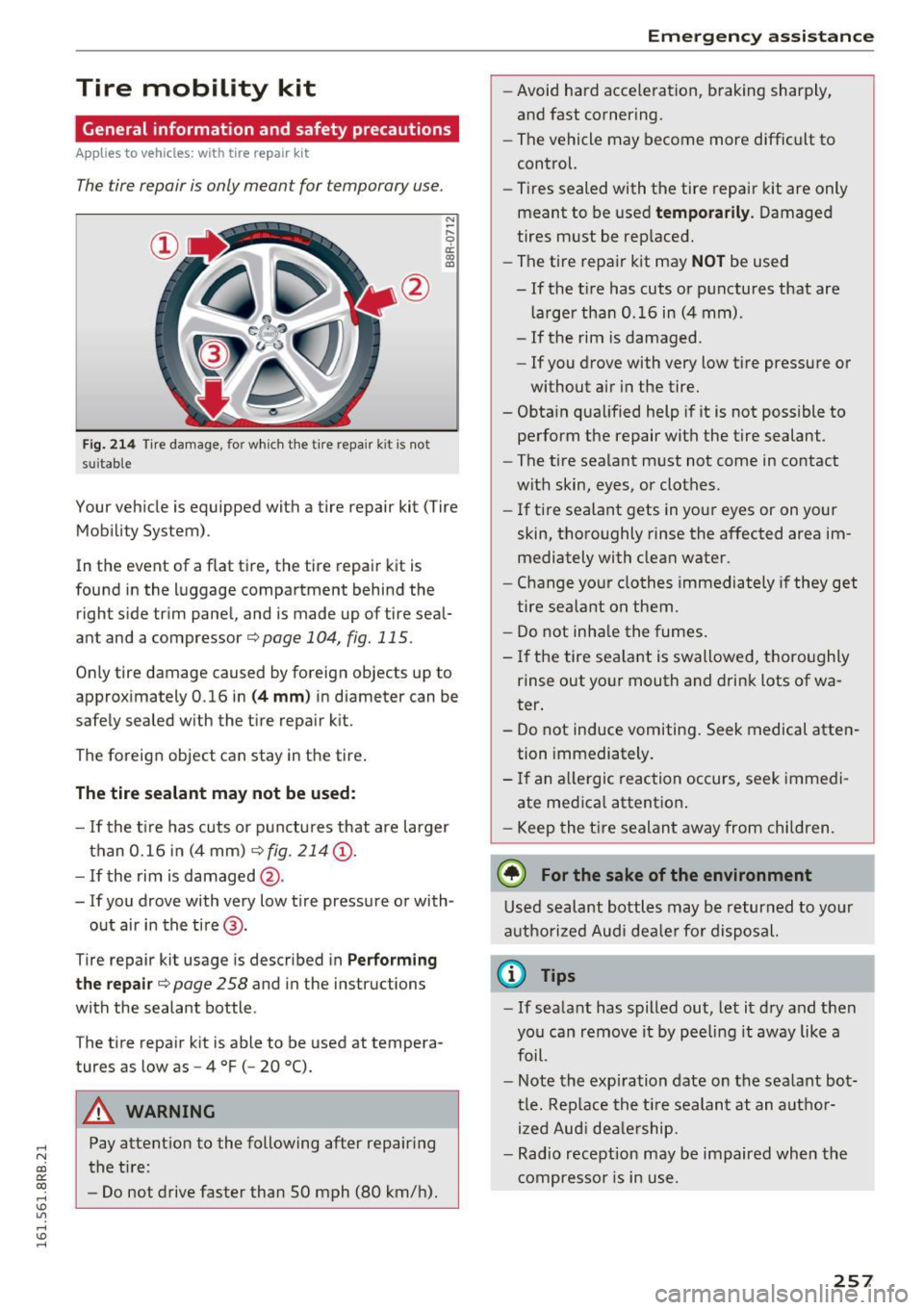
..... N
co ~ CX)
..... I.Cl U"I
..... I.Cl .....
Tire mobility kit
General information and safety precautions
Appl ies to vehicles: with tire repair kit
The tire repair is only meant for temporary use.
Fig. 214 T ire damage, for which the ti re repair kit is not
su itable
N
-r--0 ci: co ID
Your veh icle is equipped with a tire repair kit (Tire
Mobility System) .
In the event of a flat tire, the tire repair kit is
found in the luggage compartment behind the right side trim panel, and is made up of tire seal
ant and a compressor¢
page 104 , fig. 115.
Only tire damage caused by foreign objects up to
approx imately 0.16 in
( 4 mm ) in diameter can be
safely sealed with the tire repair kit.
The foreign object can stay in the tire .
The tire sealant may not be used :
-If the t i re has cuts or punctures that are larger
than 0.16 in (4 mm)
,=;,fig. 214@.
-If the rim is damaged @.
- If you drove with very low t ire pressure or with-
out air in the tire@.
Tire repair kit usage is described in
Performing
t he repai r
c;, page 258 and in the instructions
with the sealant bottle .
The tire repair kit is able to be used at tempera
tures as low as -4
°F ( -20 °().
A WARNING
Pay attent ion to the following after repairing
the tire:
- Do not drive faster than SO mph (80 km/h) .
Em ergen cy a ssis tanc e
-Avoid hard acce leration, braking sharply,
and fast cornering .
- The vehicle may become more difficult to
control.
- Tires sealed with the tire repair kit are only
meant to be used
t e mpo raril y. Damaged
tires must be replaced.
- The tire repa ir k it may
NO T be used
- If the t ire has cuts or punctures that are
larger than 0.16 in (4 mm) .
- If the rim is damaged.
- If you drove with very low tire pressure or
without air in the tire.
- Obta in qualified help if it is not possible to
perform the repair with the tire sealant.
- The tire sealant must not come in contact
with skin, eyes, or clothes.
- If tire sealant gets in you r eyes or on your
skin, thoroughly rinse the affected area im mediately with clean water .
- Change yo ur clothes immediately if they get
tire sealant on them.
- Do not inha le the fumes .
- If the tire sea la nt is swallowed, thoro ughly
rinse out your mouth and drink lots of wa
ter .
- Do not induce vomiting . Seek medical atten
tion immediately.
- If an a llergic reaction occurs, seek immedi
ate med ica l attent ion .
- Keep the t ire sealant away from child ren.
@ For the sake of the environment
Used sealant bottles may be returned to yo ur
a uthorized Audi dea le r fo r disposal.
@ Tips
- If sealant has spilled out, let it d ry and then
you ca n remove it by pee ling it away like a
foil.
- Note the expiration date on the sealant bot
tle. Rep lace the ti re sealant at an a utho r
ized Aud i dea le rship.
- Radio reception may be impaired when the
compressor is in use.
257
Page 260 of 300
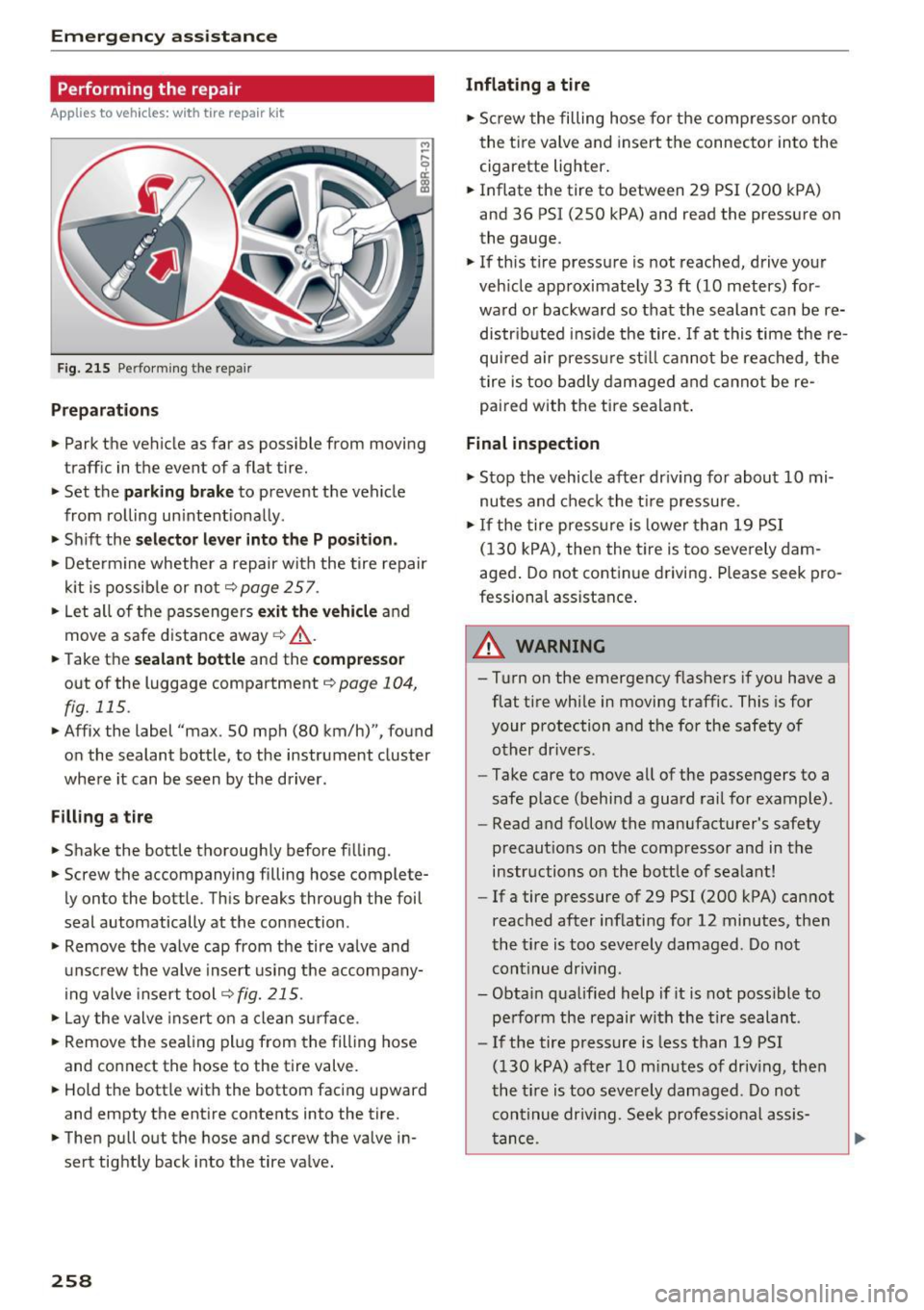
Emergency assistance
Performing the repair
Applies to vehicles: w ith tire repair k it
Fig. 215 Performing the repair
Preparations
.,. Park the vehicle as far as possible from moving
traffic in the event of a flat tire.
.,. Set the
parking brake to prevent the vehicle
from rolling unintentionally.
.,. Shift the
selector lever into the P position.
.,. Determine whether a repair with the tire repair
kit is possible or not¢
page 257.
.,. Let all of the passengers
exit the vehicle and
move a safe distance away¢_&. .
.,. Take the
sealant bottle and the compressor
out of the luggage compartment ¢ page 104,
fig. 115.
.,. Affix the label "max. 50 mph (80 km/h)", found
on the sealant bottle, to the instrument cluster
where it can be seen by the driver.
Filling a tire
.,. Shake the bottle thoroughly before filling.
.,. Screw the accompanying filling hose complete
ly onto the bottle. This breaks through the foil
seal automatically at the connection .
.,. Remove the valve cap from the tire valve and
unscrew the valve insert using the accompany
ing valve insert tool
~fig. 215.
.,. Lay the valve insert on a clean surface .
.,. Remove the sealing plug from the filling hose
and connect the hose to the tire valve .
.,. Hold the bottle with the bottom facing upward
and empty the entire contents into the tire .
.,. Then pull out the hose and screw the valve in
sert tightly back into the tire valve.
258 Inflating a tire
.,.
Screw the filling hose for the compressor onto
the tire valve and insert the connector into the
cigarette lighter.
.. Inflate the tire to between 29 PSI (200 kPA)
and 36 PSI (250 kPA) and read the pressure on
the gauge .
.,. If this tire pressure is not reached, drive your
vehicle approximately 33
ft (10 meters) for
ward or backward so that the sealant can be re
distributed inside the tire. If at this time the re
quired air pressure still cannot be reached, the
tire is too badly damaged and cannot be re
paired with the tire sealant.
Final inspection
.,. Stop the vehicle after driving for about 10 mi
nutes and check the tire pressure.
.,. If the tire pressure is lower than 19 PSI
(130 kPA), then the tire is too severely dam
aged. Do not continue driving. Please seek pro
fessional assistance .
&_ WARNING
- Turn on the emergency flashers if you have a
flat tire while in moving traffic. This is for
your protection and the for the safety of
other drivers.
- Take care to move all of the passengers to a
safe place (behind a guard rail for example) .
- Read and follow the manufacturer's safety
precautions on the compressor and in the instructions on the bottle of sealant!
- If a tire pressure of 29 PSI (200 kPA) cannot
reached after inflating for 12 minutes, then
the tire is too severely damaged. Do not
continue driving.
- Obtain qualified help if it is not possible to
perform the repair with the tire sealant .
- If the tire pressure is less than 19 PSI
(130 kPA) after 10 minutes of driving, then
the tire is too severely damaged . Do not
continue driving. Seek professional assis
tance .